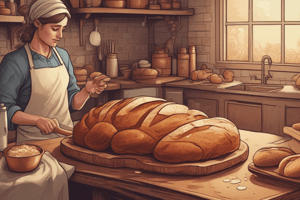Podcast
Questions and Answers
What is the primary purpose of the autolyse process in dough development?
What is the primary purpose of the autolyse process in dough development?
- To create acidity in the dough
- To initiate fermentation
- To reduce the overall mixing time
- To improve gluten structure properties (correct)
What is the minimum time required for the autolyse process to be effective?
What is the minimum time required for the autolyse process to be effective?
- 5 minutes
- 15 to 20 minutes (correct)
- 1 hour
- 30 minutes
What is the role of proteases in the autolyse process?
What is the role of proteases in the autolyse process?
- To slow down the mixing process
- To degrade protein bonds (correct)
- To strengthen gluten bonds
- To initiate fermentation
What is the effect of yeast on the autolyse process?
What is the effect of yeast on the autolyse process?
What is the benefit of autolysing only a portion of the dough?
What is the benefit of autolysing only a portion of the dough?
What is the effect of salt on the autolyse process?
What is the effect of salt on the autolyse process?
What is the definition of extensibility in the context of dough?
What is the definition of extensibility in the context of dough?
Who is credited with developing the autolyse process?
Who is credited with developing the autolyse process?
What happens to the proteins of the flour during the autolyse process?
What happens to the proteins of the flour during the autolyse process?
What is the natural action of the enzyme protease in the autolyse process?
What is the natural action of the enzyme protease in the autolyse process?
Why is it necessary to add yeast, salt, and stiff preferments to the dough after an autolyse?
Why is it necessary to add yeast, salt, and stiff preferments to the dough after an autolyse?
What is the advantage of autolysing only a portion of the dough?
What is the advantage of autolysing only a portion of the dough?
How does the autolyse process impact the machinability of the dough?
How does the autolyse process impact the machinability of the dough?
What is the relationship between the autolyse time and the activity of the enzymes?
What is the relationship between the autolyse time and the activity of the enzymes?
How does the autolyse process impact the final texture of the bread?
How does the autolyse process impact the final texture of the bread?
What is the significance of the enzymatic activity during the autolyse process?
What is the significance of the enzymatic activity during the autolyse process?
Flashcards are hidden until you start studying
Study Notes
Autolyse Process
- Developed by Professor Raymond Calvel, a French Master Baker
- Involves mixing flour and water, then resting for a minimum of 15-20 minutes
Reactions during Autolyse
- Proteins in flour become better hydrated, leading to better gluten structure properties (strength and gas retention)
- Natural action of protease enzyme, present in flour, degrades some gluten bonds, making dough more extensible and improving machinability
Enzymes and Proteases
- Enzymes are organic components with specific and natural actions of degradation
- Proteases are responsible for protein degradation and are present in flour
Autolyse Timing
- Minimum of 15-20 minutes necessary to activate enzymes
- Can last up to 1 hour for bulk of dough
- Alternative: autolyse only a portion of dough (with a portion of flour) for a longer period (8-12 hours or overnight)
Autolyse Benefits and Limitations
- Allows for better gluten structure and more extensible dough
- Yeast, salt, and stiff preferments are added after autolyse, as they counter its effects
- Salt slows protease action, while yeast fermentation creates acidity, increasing dough strength and decreasing extensibility
Autolyse Process
- Developed by Professor Raymond Calvel, a French Master Baker
- Involves mixing flour and water, then resting for a minimum of 15-20 minutes
Reactions during Autolyse
- Proteins in flour become better hydrated, leading to better gluten structure properties (strength and gas retention)
- Natural action of protease enzyme, present in flour, degrades some gluten bonds, making dough more extensible and improving machinability
Enzymes and Proteases
- Enzymes are organic components with specific and natural actions of degradation
- Proteases are responsible for protein degradation and are present in flour
Autolyse Timing
- Minimum of 15-20 minutes necessary to activate enzymes
- Can last up to 1 hour for bulk of dough
- Alternative: autolyse only a portion of dough (with a portion of flour) for a longer period (8-12 hours or overnight)
Autolyse Benefits and Limitations
- Allows for better gluten structure and more extensible dough
- Yeast, salt, and stiff preferments are added after autolyse, as they counter its effects
- Salt slows protease action, while yeast fermentation creates acidity, increasing dough strength and decreasing extensibility
Studying That Suits You
Use AI to generate personalized quizzes and flashcards to suit your learning preferences.



